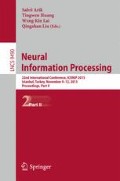Abstract
The spiking neural network (SNN) model has been an important topic in the past two decades. Many training algorithms, such as SpikeProp, were designed and applied to various applications. However, the fault tolerant ability in SNNs was not fully understood. Based on our study, the SNN model with the classical training objective function cannot even handle the single fault situation, in which one of the hidden neurons is damage. To improve the fault tolerant ability, we design an objective function and utilize the particle swarm optimization approach to minimize it. Simulation results show that our approach is much better than the classical objective function.
Access this chapter
Tax calculation will be finalised at checkout
Purchases are for personal use only
References
Maass, W.: Networks of spiking neurons: the third generation of neural network models. Neural Networks 10(9), 1659–1671 (1997)
Maass, W.: Fast sigmoidal networks via spiking neurons. Neural Comput. 9(2), 279–304 (1997)
Bohte, S.M., Kok, J.N., Poutre, H.L.: Error-backpropagation in temporally encoded networks of spiking neurons. Neurocomputing 48(1), 17–37 (2002)
Booij, O.: Temporal pattern classification using spiking neural networks. Unpublished master’s thesis, University of Amsterdam (2004)
Lewicki, M.S.: Efficient coding of natural sounds. Nat. Neurosci. 5(4), 356–363 (2002)
Maass, W., Bishop, C.M.: Pulsed Neural Networks. MIT Press, Cambridge (2001)
Matsugu, M., Mori, K., Ishii, M., Mitarai, Y.: Convolutional spiking neural network model for robust face detection. In: Proceedings of ICONIP 2002, vol. 2, pp. 660–664 (2002)
Zhang, X., Song, S., Wu, C.: Robust Bayesian classification with incomplete data. Cogn. Comput. 5(2), 170–187 (2013)
Zhou, Z.-H., Chen, S.F.: Evolving fault-tolerant neural networks. Neural Comput. Appl. 11(3–4), 156–160 (2003)
Leung, C.S., Sum, J.: A fault-tolerant regularizer for RBF networks. IEEE Trans. Neural Networks 19(3), 493–507 (2008)
Leung, C.S., Sum, J.: RBF networks under the concurrent fault situation. IEEE Trans. Neural Netw. Learn. Syst. 23(7), 1148–1155 (2012)
Oya, T., Asai, T., Amemiya, Y., Schmid, A., Leblebici, Y.: Single-electron circuit for inhibitory spiking neural network with fault-tolerant architecture. In: Proceedings of IEEE International Symposium on Circuits and Systems, pp. 2535–2538 (2005)
Venter, G., Sobieszczanski-Sobieski, J.: Particle swarm optimization. AIAA J. 41(8), 1583–1589 (2003)
Natschlager, T., Ruf, B.: Spatial and temporal pattern analysis via spiking neurons. Network: Comput. Neural Syst. 9(3), 319–332 (1998)
Gerstner, W.: Time structure of the activity in neural network models. Phys. Rev. E 51(1), 738 (1995)
Ho, K., Leung, C.S., Sum, J.: Convergence and objective functions of some fault/noise-injection-based online learning algorithms for RBF networks. IEEE Trans. Neural Networks 21(6), 938–947 (2010)
Ratnaweera, A., Halgamuge, S., Watson, H.C.: Self-organizing hierarchical particle swarm optimizer with time-varying acceleration coefficients. IEEE Trans. Evol. Comput. 8(3), 240–255 (2004)
Acknowledgement
The work was supported by the General Research Fund from Hong Kong (Project No.: CityU 116511).
Author information
Authors and Affiliations
Corresponding author
Editor information
Editors and Affiliations
Rights and permissions
Copyright information
© 2015 Springer International Publishing Switzerland
About this paper
Cite this paper
Feng, R., Leung, CS., Tsang, P. (2015). Realization of Fault Tolerance for Spiking Neural Networks with Particle Swarm Optimization. In: Arik, S., Huang, T., Lai, W., Liu, Q. (eds) Neural Information Processing. ICONIP 2015. Lecture Notes in Computer Science(), vol 9490. Springer, Cham. https://doi.org/10.1007/978-3-319-26535-3_10
Download citation
DOI: https://doi.org/10.1007/978-3-319-26535-3_10
Published:
Publisher Name: Springer, Cham
Print ISBN: 978-3-319-26534-6
Online ISBN: 978-3-319-26535-3
eBook Packages: Computer ScienceComputer Science (R0)

